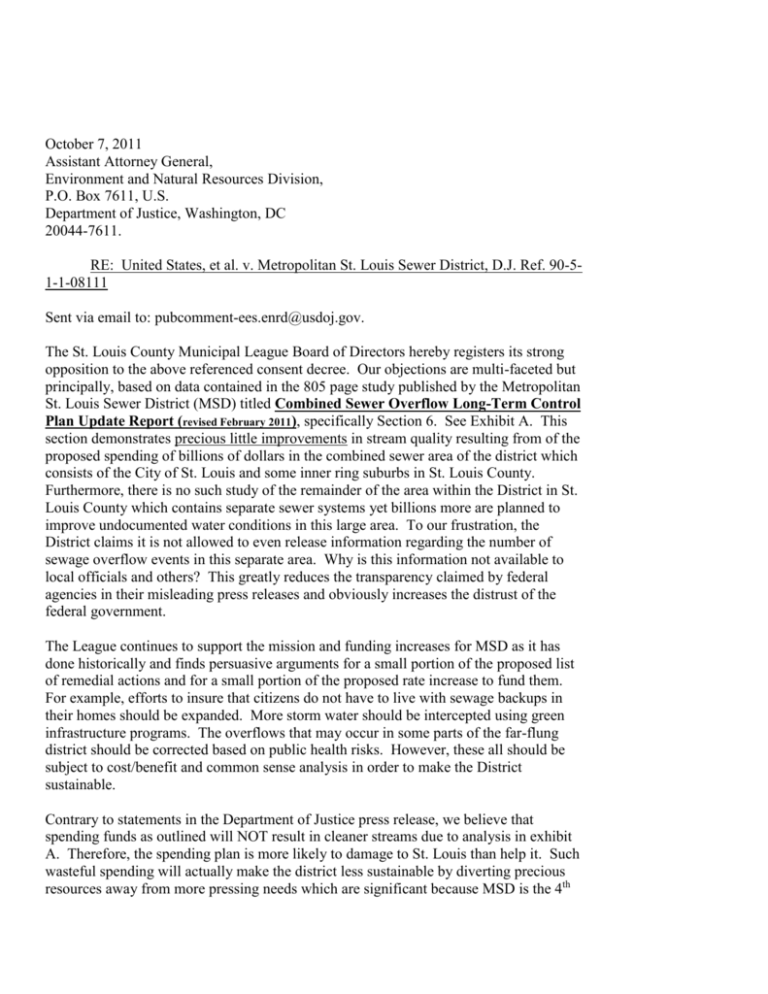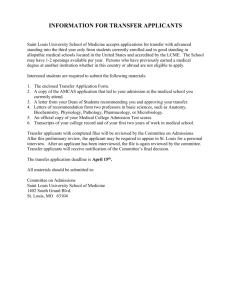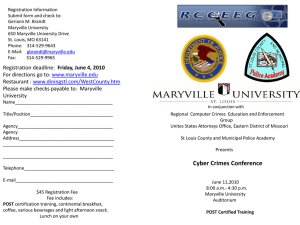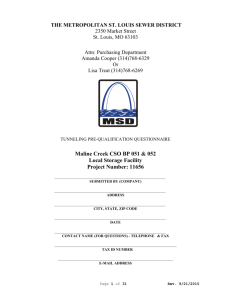EPA/MSD Consent Decree Objections
advertisement

October 7, 2011 Assistant Attorney General, Environment and Natural Resources Division, P.O. Box 7611, U.S. Department of Justice, Washington, DC 20044-7611. RE: United States, et al. v. Metropolitan St. Louis Sewer District, D.J. Ref. 90-51-1-08111 Sent via email to: pubcomment-ees.enrd@usdoj.gov. The St. Louis County Municipal League Board of Directors hereby registers its strong opposition to the above referenced consent decree. Our objections are multi-faceted but principally, based on data contained in the 805 page study published by the Metropolitan St. Louis Sewer District (MSD) titled Combined Sewer Overflow Long-Term Control Plan Update Report (revised February 2011), specifically Section 6. See Exhibit A. This section demonstrates precious little improvements in stream quality resulting from of the proposed spending of billions of dollars in the combined sewer area of the district which consists of the City of St. Louis and some inner ring suburbs in St. Louis County. Furthermore, there is no such study of the remainder of the area within the District in St. Louis County which contains separate sewer systems yet billions more are planned to improve undocumented water conditions in this large area. To our frustration, the District claims it is not allowed to even release information regarding the number of sewage overflow events in this separate area. Why is this information not available to local officials and others? This greatly reduces the transparency claimed by federal agencies in their misleading press releases and obviously increases the distrust of the federal government. The League continues to support the mission and funding increases for MSD as it has done historically and finds persuasive arguments for a small portion of the proposed list of remedial actions and for a small portion of the proposed rate increase to fund them. For example, efforts to insure that citizens do not have to live with sewage backups in their homes should be expanded. More storm water should be intercepted using green infrastructure programs. The overflows that may occur in some parts of the far-flung district should be corrected based on public health risks. However, these all should be subject to cost/benefit and common sense analysis in order to make the District sustainable. Contrary to statements in the Department of Justice press release, we believe that spending funds as outlined will NOT result in cleaner streams due to analysis in exhibit A. Therefore, the spending plan is more likely to damage to St. Louis than help it. Such wasteful spending will actually make the district less sustainable by diverting precious resources away from more pressing needs which are significant because MSD is the 4th largest sewer system in the United States and it has at-risk, aging infrastructure. With inflation, there is little doubt that monthly sanitary sewer bills for residential customers will grow to over $100 per month, with commercial bills increasing even more. This does not take into consideration the need to raise fees for storm water improvements, which have historically been under-funded in the District. And we may need to raise fees even more for sanitary sewer improvements not related to the decree. The EPA must rely on better science to avoid massive, wasteful increases if it desires to see sewage services in the United States operate effectively. Together, the unnecessary rate increases associated with the largely misdirected consent decree and the needed storm water fees will further reduce the base of ratepayers available to support the district. This is because the higher rates will become one more incentive to leave the District or discourage economic development within the District. The District base has already contracted as reported in the MSD reports. If anything, we need a process that will increase the base and thereby spread the increased fees across a broader group of rate payers, if we hope to develop the resources that the District needs to meet real clean water goals. To put this District risk in perspective, please note the following from a May 22, 2011 article in the St. Louis Post Dispatch that stated: “For five decades, population has been draining out of St. Louis. In the past 10 years, St. Louis County lost people, too. Now it's clear that the jobs are following the people. The number of jobs in St. Louis fell by nearly 14 percent between 2000 and last year, the tumble outpacing its 8 percent population slide, according to figures from the Bureau of Labor Statistics. In St. Louis County, jobs dropped by 13 percent, even though it only lost 2 percent of its population….” This proposal to dramatically increase rates with little or no State or federal financial support or documented benefit will significantly impact rate payers. Had the February MSD study indicated that the bulk of the increase would result in cleaner streams or if there was any documentation of illnesses or even complaints of odors due to the occasional overflows, we would have likely recommended some modifications. This likely would have been along the lines that the increase be reduced and the number of years to build the improvements be lengthened so that rate shock would not drive rate payers from the District. Lower increases over more years would also allow modest income residents, businesses and others more time to adjust, especially in light of the hang-over from the recession, the high foreclosure rate, etc. However, since exhibit A shows almost no clean water benefits from the billions of dollars proposed to reduce the number of overflows, we cannot support simply lower increases over more years because the remedy will not necessarily protect the environment and human health to any significant degree, if at all, as the EPA civil enforcement program intended. The EPA efforts did not determine risk-based priorities (as it advertises). Exhibit A clearly shows this. Should EPA and the Department of Justice wish to reach real goals, other strategies must be considered and reasonable user fees determined. MSD has supplied $2.3 billion over the past two decades to eliminate 300-plus sewer overflows. The problem has not been ignored or trivialized. Other huge expenditures have been made to clean our wastewater. Effort should continue where problems are significant and improvements would really be beneficial. However, misguided federal regulations that are ineffective and result in little or no water quality or public health improvements should not drive this process; science, engineering and wise stewardship of public funds should. To add insult to injury, the settlement recommends that our hard pressed district pay the federal government a $1.2 million settlement and agree to onerous monitoring and further sanctions. It is difficult to imagine that Congress ever imagined that agencies and citizens therein trying to comply with the unintended consequences of federal laws and unfunded federal mandates would somehow have to take rate payers funds to pay this same federal agency for the privilege of being harassed now in federal court and prospectively via the decree when that harassment ignores the evidence in exhibit A. That money and effort should be used for the very improvements that lack funding today, such as reducing basement backups; an EPA which genuinely supports true sewerage improvements should agree. In the strongest terms possible, we urge the federal agencies and courts and other parties to postpone any consent decree and instill some sanity in this process. All should return to the negotiating table to construct a plan that calls for significant, measurable public health improvements before mandating (or threatening) sanctions that result in diverting billions of dollars needed for real improvements to the District infrastructure. Are we not capable of getting this right? Sincerely, Tim Fischesser, Executive Director Attachment: Exhibit A (Combined Sewer Overflow Long-Term Control Plan Update Report (revised February 2011), Section 6) cc Missouri Senator Claire McCaskill Missouri Senator Roy Blunt Missouri Congressman Lacy Clay Missouri Congressman Russ Carnahan Missouri Congressman Todd Akin Missouri Governor Jay Nixon Sara Parker Pauley, Director, Missouri Department of Natural Resources Karl Brooks, EPA Regional Administrator Charlie Dooley, St. Louis County Executive Francis Slay, Mayor, City of St. Louis Jeff Theerman, Executive Director, Metropolitan St. Louis Sewer District cc added 10/11/11 Carol Jackson, US District Judge, Eastern District of Missouri Ignacia Moreno, Assistant Attorney General, Environment and Natural Resources Kathryn MacDonald, Senior Attorney, Environmental Enforcement Section Sara Wyche, Trial Attorney, Environmental Enforcement Section Robert Maher, Assistant Section Chief, Environmental Enforcement Section Richard Callahan, US Attorney, Eastern District of Missouri Cynthia Giles, Assistant Administrator, Office of Enforcement and Compliance Assurance Adam Kushner, Director, Office of Civil Enforcement Mark Pollins, Director, Water Enforcement Division Andrew Cherry, Attorney Advisor, Water Enforcement Division Joanna Day, Attorney Advisor, Water Enforcement Division David Cozad, EPA Regional Counsel Elizabeth Huston, EPA Assistant Regional Counsel Kathleen Smith, Executive Director, Missouri Coalition for the Environment Foundation Elizabeth Hubertz, Clinic Attorney, Inter Disciplinary Environmental Clinic Susan Myers, MSD General Counsel









